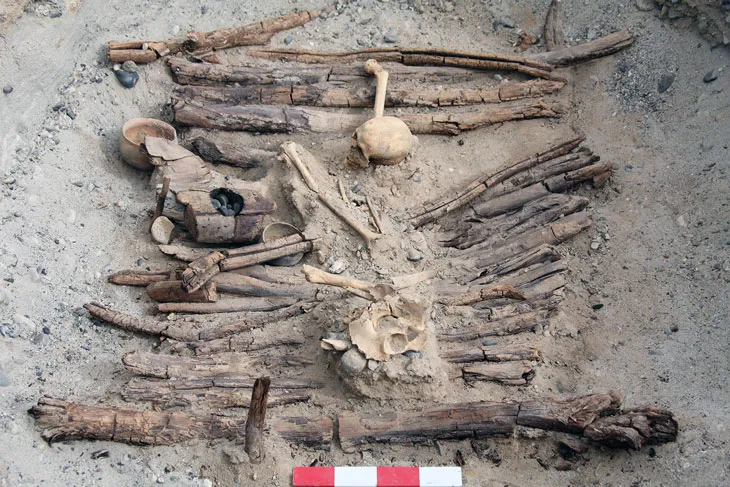Mourners convened at a cemetery in what is now western China approximately 2,500 years ago to partake in the inhalation of fumes emanating from burning cannabis plants contained within small wooden vessels. The elevated levels of the psychoactive component THC in these ignited plants, commonly known as marijuana, would have induced altered states of consciousness.
According to a team led by archaeologist Yimin Yang from the University of Chinese Academy of Sciences in Beijing, this practice is evidenced at the Jirzankal Cemetery in Central Asia’s Pamir Mountains. Residues of chemicals found on wooden burners excavated from tombs in the area constitute some of the earliest evidence to date of the smoking or inhalation of cannabis fumes, as reported by the researchers on June 12 in Science Advances. The team speculates that rituals aimed at communing with the deceased or with a spiritual realm likely involved the smoking of cannabis.
Although cannabis remains of similar antiquity have been discovered in various other Central Asian burial sites, such as one in the Altai Mountains of Russia situated approximately 3,000 kilometers northwest of the Pamir Mountains, the findings at Jirzankal Cemetery offer a unique insight into the initial utilization of cannabis as a substance for altering consciousness, according to the researchers. While East Asians began cultivating cannabis for its oily seeds and for the production of clothing and rope from its fibers at least 6,000 years ago, early cultivated varieties in East Asia and elsewhere, much like most wild strains of the plant, contained low levels of THC and other psychoactive compounds.
Historically, some of the earliest documented instances of cannabis smoking are attributed to the accounts of the Greek historian Herodotus, who mentioned cannabis smoking approximately 2,500 years ago on the Central Asian steppes, situated about 2,000 kilometers west of the Pamir Mountains. However, pinpointing the exact time and location of the emergence of high-THC cannabis plants and identifying the earliest practitioners of cannabis smoking has long remained a challenge for scientists.
Significantly, the high-altitude mountain passes of Central and East Asia, including the Pamir region, served as pivotal trade routes for the early Silk Road, connecting China with West Asia and Europe, as noted by archaeobotanist and co-author of the study, Robert Spengler, from the Max Planck Institute for the Science of Human History in Jena, Germany. Spengler emphasized at a June 11 press briefing that their research suggests that the knowledge of cannabis smoking and specific high-THC varieties of the cannabis plant were among the cultural practices disseminated along the Silk Road exchange routes.
Archaeological evidence indicates that various burial customs had spread across Central and East Asia approximately 2,500 years ago. Thus, cannabis smoking during funerary rites likely played a role in this diffusion process, according to archaeologist Michael Frachetti of Washington University in St. Louis, who was not involved in the recent study. Frachetti points out that during that era, the early Silk Road connected populations from Beijing to Venice. Consequently, in light of these new discoveries, archaeologist David Anthony of Hartwick College in Oneonta, N.Y., suggests that sites in the Altai Mountains merit closer examination for insights into the origins of cannabis smoking.

Supporting the Pamir region’s status as an ancient crossroads, previous chemical analyses of human remains from Jirzankal Cemetery revealed that 10 out of 34 individuals tested had originated from outside the area. Furthermore, artifacts found in certain Jirzankal tombs, such as silk fabrics from eastern China and a type of harp from West Asia, indicate the presence of people from diverse cultures who traversed Central Asia.
Situated over 3,000 meters above sea level, Jirzankal Cemetery features black and white stone strips on its surface, with circular mounds covering the tombs, typically encircled by one or two rings of stones.
Yang’s research team detected a chemical signature of cannabis on charred plant material from ten wooden burners, or braziers, discovered in eight tombs at Jirzankal. Additionally, chemical indications of an unusually high level of THC were present inside nine braziers and on two stones that had been heated and used to burn plants in the braziers.
However, as Spengler noted, these ancient plants would have likely elicited less potent psychoactive effects compared to present-day cannabis plants specifically bred for high THC levels.
The cultivation of high-THC cannabis plants by the individuals who interred their deceased at Jirzankal Cemetery, or the utilization of naturally occurring psychoactive varieties, remains uncertain. Nonetheless, Frachetti speculates that the practice of inhaling cannabis as part of mind-altering burial rituals likely originated millennia before mourners congregated at the tombs of Jirzankal.



